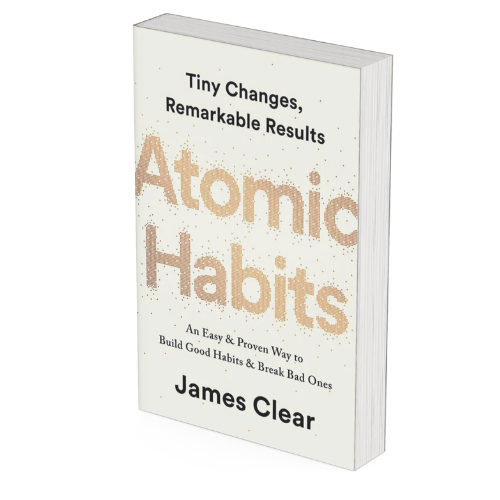Atomic Habits
by James Clear
The Author
James Clear is a renowned author, lecturer, and specialist on habits, decision-making, and continuous development. Atomic Habits has sold over 5 million copies worldwide and translated into over 50 languages. Clear’s work is based on scientific research and aims to help individuals and organisations better via tiny, consistent adjustments. His views have been featured in major magazines such as The New York Times, Time, and Entrepreneur, and his popular newsletter reaches hundreds of thousands of readers weekly.
Summary of “Atomic Habits”
This book is a detailed and practical guide to understanding and developing habits that result in significant personal and professional changes. The book’s central thesis is that modest, consistent adjustments, or “atomic habits,” can result in substantial, long-term outcomes. Clear describes his process using a framework known as the Four Laws of Behaviour Change, which includes:
- Make It Obvious (Cue): Identifying and creating unambiguous signals to elicit desired behaviours.
- Make It Attractive (Craving): Increasing the attraction of habits to boost motivation.
- Make It Easy (Response): Simplifying practices to decrease friction and facilitate adoption.
- Make It Satisfying (Reward): Use instant rewards to strengthen the habit loop.
Clear divides the habit development process into four key steps: trigger, desire, response, and reward. This framework explains the fundamental principles of habits and offers practical solutions for developing healthy habits and breaking negative ones.
The book contains extensive scientific research, real-life examples, and practical guidance. Clear emphasises the necessity of concentrating on systems rather than individual aims. He believes good habits are about developing a long-term process that leads to ongoing progress rather than merely achieving a single result.
My thoughts on “Atomic Habits.”
Reading James Clear’s “Atomic Habits” has been instructive and transformative. The book’s practical approach to habit creation and transformation is entirely consistent with the ideals I promote as a psychotherapist and coach.
One of the most critical takeaways from Clear’s book is the transition from objectives to systems. Clear contends that objectives are about the outcomes you want, whereas systems are about the procedures that lead to those results. This strongly resonates with my idea of constant growth and resilience. Individuals may cultivate long-term success by concentrating on the development of successful systems.
In my work, I frequently see clients obsessed with obtaining specific objectives yet failing to sustain the behaviours required to get there. Clear’s emphasis on systems promotes a more sustainable and stress-free personal and professional development approach. It fosters an attitude of continuous progress rather than a focus on specific accomplishments.
Clear’s notion of “atomic habits” emphasises the need to make small, gradual adjustments. This notion is consistent with the cognitive-behavioural strategies I employ to assist clients in managing and overcoming anxiety and depression. Small, reasonable stages are less intimidating and more realistic, resulting in incremental but considerable progress.
For example, while dealing with anxiety, I urge clients to take little steps towards facing their concerns rather than aiming to overcome them all at once. This technique boosts confidence and creates a pattern of success that encourages positive behaviour.
Clear presents the notion of habit stacking, which involves tying new behaviours to old ones to make them simpler to acquire. This strategy is very beneficial for establishing new habits and behaviours. By building on their habits, clients may smoothly integrate new, beneficial activities into their everyday lives.
Specifying the specific time and location for a new habit increases the chance of success. This technique removes uncertainty and gives a defined action plan, making it easier.
Clear’s insights regarding how the environment influences behaviour are beneficial. He emphasises that our environment has a significant impact on our behaviours. Individuals may foster growth by creating surroundings that encourage positive habits while minimising exposure to negative habit triggers.
In therapy, I frequently emphasise the importance of the environment with clients, whether providing a calm room for mindfulness practice or organising their workspace to decrease distractions. Clear’s emphasis on environment design emphasises that we can manipulate and optimise our surroundings to achieve our objectives.
One of the most essential ideas in “Atomic Habits” is the concept of identity-based habits, which emphasise being the person you want to be rather than what you want to achieve. Clear indicates that our behaviours represent our identity. We may achieve long-term transformation by adjusting our self-image and aligning our routines with our intended identity.
This strategy is highly effective in treatment. For example, assisting clients to identify as “non-smokers” rather than persons attempting to stop smoking might lead to more robust long-term behaviour change. By matching their activities with their intended identity, clients may reinforce positive behaviours and increase their feelings of self-efficacy.
Using the concepts from “Atomic Habits,” I urge clients and coworkers to:
- Focus on Systems
Instead of focusing on individual goals, create effective systems promoting continual growth. - Make modest adjustments
Recognise the value of making modest, incremental adjustments to develop long-term habits. - Use Habit Stacking
Link new habits to old ones to make adoption simpler.
Design supportive environments that promote desirable behaviours while reducing negative ones. - Develop Identity-Based Habits
Focus on being the person you want to be by aligning your behaviours with your desired identity.
In summary, James Clear’s “Atomic Habits” gives a solid foundation for understanding and adopting good habits. Its unique combination of scientific research, practical tactics, and real-life examples makes it an essential resource for anybody looking to enhance their personal or professional lives. As a psychotherapist and educator, Clear’s insights have tremendously influenced me. I am excited to incorporate these ideas into my work to assist clients in achieving long-term growth and fulfilment.
Atomic Habits
by James Clear
The Author
James Clear is a renowned author, lecturer, and specialist on habits, decision-making, and continuous development. Atomic Habits has sold over 5 million copies worldwide and translated into over 50 languages. Clear’s work is based on scientific research and aims to help individuals and organisations better via tiny, consistent adjustments. His views have been featured in major magazines such as The New York Times, Time, and Entrepreneur, and his popular newsletter reaches hundreds of thousands of readers weekly.
Summary of “Atomic Habits”
This book is a detailed and practical guide to understanding and developing habits that result in significant personal and professional changes. The book’s central thesis is that modest, consistent adjustments, or “atomic habits,” can result in substantial, long-term outcomes. Clear describes his process using a framework known as the Four Laws of Behaviour Change, which includes:
- Make It Obvious (Cue): Identifying and creating unambiguous signals to elicit desired behaviours.
- Make It Attractive (Craving): Increasing the attraction of habits to boost motivation.
- Make It Easy (Response): Simplifying practices to decrease friction and facilitate adoption.
- Make It Satisfying (Reward): Use instant rewards to strengthen the habit loop.
Clear divides the habit development process into four key steps: trigger, desire, response, and reward. This framework explains the fundamental principles of habits and offers practical solutions for developing healthy habits and breaking negative ones.
The book contains extensive scientific research, real-life examples, and practical guidance. Clear emphasises the necessity of concentrating on systems rather than individual aims. He believes good habits are about developing a long-term process that leads to ongoing progress rather than merely achieving a single result.
My thoughts on “Atomic Habits.”
Reading James Clear’s “Atomic Habits” has been instructive and transformative. The book’s practical approach to habit creation and transformation is entirely consistent with the ideals I promote as a psychotherapist and coach.
One of the most critical takeaways from Clear’s book is the transition from objectives to systems. Clear contends that objectives are about the outcomes you want, whereas systems are about the procedures that lead to those results. This strongly resonates with my idea of constant growth and resilience. Individuals may cultivate long-term success by concentrating on the development of successful systems.
In my work, I frequently see clients obsessed with obtaining specific objectives yet failing to sustain the behaviours required to get there. Clear’s emphasis on systems promotes a more sustainable and stress-free personal and professional development approach. It fosters an attitude of continuous progress rather than a focus on specific accomplishments.
Clear’s notion of “atomic habits” emphasises the need to make little, gradual adjustments. This notion is consistent with the cognitive-behavioural strategies I employ to assist clients to manage and overcome anxiety and depression. Small, reasonable stages are less intimidating and more realistic, resulting in incremental but considerable progress.
For example, while dealing with anxiety, I urge clients to take little steps towards facing their concerns rather than aiming to overcome them all at once. This technique boosts confidence and creates a pattern of success that encourages positive behaviour.
Clear presents the notion of habit stacking, which involves tying new behaviours to old ones to make them simpler to acquire. This strategy is very beneficial for establishing new habits and behaviours. Clients may smoothly integrate new, beneficial activities into their everyday lives by building on their habits.
Specifying the specific time and location for a new habit increases the chance of success. This technique removes uncertainty and gives a defined action plan, making it easier.
Clear’s insights regarding how the environment influences behaviour are beneficial. He emphasises that our environment has a significant impact on our behaviours. Individuals may foster growth by creating surroundings that encourage positive habits while minimising exposure to negative habit triggers.
In therapy, I frequently emphasise the importance of the environment with clients, whether providing a calm room for mindfulness practice or organising their workspace to decrease distractions. Clear’s emphasis on environment design emphasises that we can manipulate and optimise our surroundings to achieve our objectives.
One of the most essential ideas in “Atomic Habits” is the concept of identity-based habits, which emphasise being the person you want to be rather than what you want to achieve. Clear indicates that our behaviours represent our identity. We may achieve long-term transformation by adjusting our self-image and aligning our routines with our intended identity.
This strategy is highly effective in treatment. For example, assisting clients to identify as “non-smokers” rather than persons attempting to stop smoking might lead to more robust long-term behaviour change. By matching their activities with their intended identity, clients may reinforce positive behaviours and increase their feelings of self-efficacy.
Using the concepts from “Atomic Habits,” I urge clients and coworkers to:
- Focus on Systems
Instead of focusing on individual goals, create effective systems promoting continual growth. - Make modest adjustments
Recognise the value of making modest, incremental adjustments to develop long-term habits. - Use Habit Stacking
Link new habits to old ones to make adoption simpler.
Design supportive environments that promote desirable behaviours while reducing negative ones. - Develop Identity-Based Habits
Focus on being the person you want to be by aligning your behaviours with your desired identity.
In summary, James Clear’s “Atomic Habits” gives a solid foundation for understanding and adopting good habits. Its unique combination of scientific research, practical tactics, and real-life examples makes it an essential resource for anybody looking to enhance their personal or professional lives. As a psychotherapist and educator, Clear’s insights have tremendously influenced me. I am excited to incorporate these ideas into my work to assist clients in achieving long-term growth and fulfilment.
“A man becomes a man when a man is needed. I’ve seen 40-year-old children cause a man was never needed”
Recent Thoughts
When Love Turns to Hate: Why Justice Must Stay in the Courtroom and Not Online
As a therapist working closely with couples and individuals in high-conflict relationships, I have seen the full emotional arc of love, from intimacy
Stress at the Top
Why Leadership in Malta is More Isolated Than You Think We often picture business leaders as confident, driven, and in control. They make




